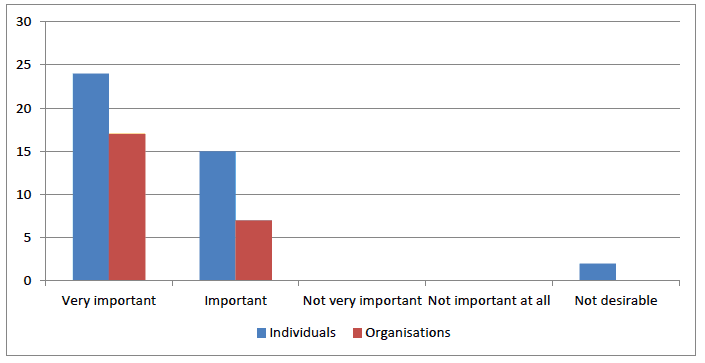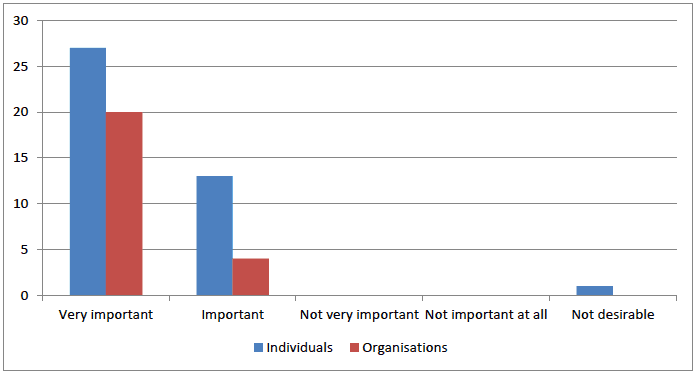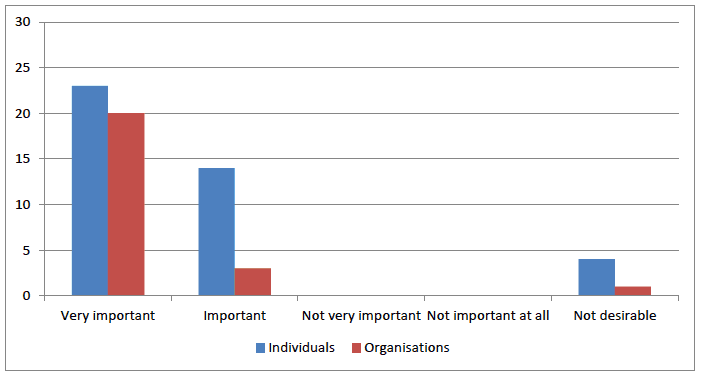Safe and effective staffing in health and social care: analysis of responses
An analysis of responses received to the discussion document on safe and effective staffing in health and social care.
Section 5 – Role of the sector in identification of the social care settings for which there may be a need for development and application of validated tools and methodologies and for inclusion within legislation
In Health Boards, the Nursing and Midwifery Workload and Workforce Planning Programme has taken an evidence based approach to workload and workforce planning. The ground-breaking approach, tools and methodologies have been developed over a number of years with investment of considerable time and resource. It was recognised within the discussion document that similar effort and investment will be needed for the development of approaches suitable for specific social care settings.
It will be important that, as for the Nursing and Midwifery Workload and Workforce Planning Programme, the sector itself is fully engaged in development and validation of tools and methodologies that are appropriate for specified settings. It will also be important that the sector supports any future use of legislation through regulations to require use of newly developed tools.
Question 5a: How important do you consider the suggestions below are in providing possible routes for the social care sector to be fully engaged in the development and validation of approaches appropriate for a specified setting?
i. To work with employers/service providers and commissioners from the sector to identify and agree specified settings where there is a need for the development of workforce planning tools and methodologies.

ii. To work with service providers and commissioners from the appropriate parts of the sector to develop and validate workforce planning tools and methodologies to demonstrate that they are practicable and beneficial for specific settings.

iii. To consult with the sector before a requirement to use validated workforce planning tools and methodologies is confirmed in regulations.

Question 5a of the consultation asked respondents to rate the above statements as Very Important, Important, Not Very Important, Not Important At All or Not Desirable.
In all 3 suggestions posed above, over 90% of respondents, from both organisations and individuals, rated the suggestions as Very Important or Important.
Question 5b: Are there any other routes you think should be considered to ensure appropriate engagement with the social care sector?
A total of 32 responses were received to this question, the most common themes identified were:
| Theme | No. of responses | Percentage |
|---|---|---|
| Engagement with staff groups | 11 | 34% |
| Engagement with service users | 8 | 25% |
| Engagement with trade unions | 4 | 13% |
Other themes that emerged from responses included engagement with professional bodies, consideration of service user demography, engagement with sector regulators, and awareness of the lessons learned from the health sector when creating tools for new areas.
Question 5c: Please identify any settings where you think the development of appropriate workload and workforce planning tool or methodology is most important; and any care settings where you think this is not relevant or required.
A total of 42 responses were received to this question.
There was no clear consensus on settings where development of tools would be most important. Whilst a number of respondents indicated that all care settings should be covered (7 respondents, 17%) a large range of possible settings were also identified within social care. These included care homes and nursing homes, mainstream social work teams, elderly day hospitals, residential child care and residential homes.
There were several responses that highlighted health care settings such as perioperative care, elderly care, maternity services, mental health services and trauma services. However each of these settings already have a tool or methodology in place for workforce and workload planning.
One response (from an organisation) highlighted that there may be a challenge in respect of Self Directed Support and how this may be impacted by the legislation. However the proposed legislation, as outlined in the discussion document, would apply to registered care service providers only and therefore not impact individuals using Self Directed Support budgets to directly employ Personal Assistants.
One respondent (an individual) mentioned a care setting where they believed a workload and workforce planning tool or methodology was not relevant or required, which was Hospital at Home. However they qualified this by stating this was due to it being too small at this time but may be relevant in the future.
Contact
There is a problem
Thanks for your feedback